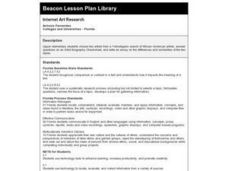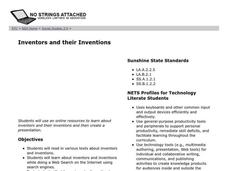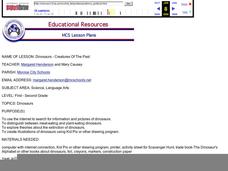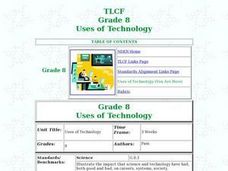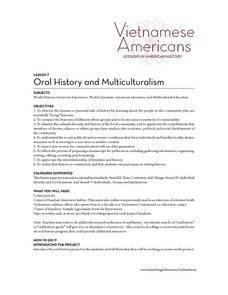Curated OER
Historical Research Using the Internet
Students complete Internet research based on historical origin of something of their choosing, and discuss procedures and options for conducting successful search. Students then collect and interpret data, consider various ways to...
Curated OER
Thrust to Weight Ratio
Students, after reading the Web page Thrust to Weight Ratio, use Range Games and the Air Page to complete the activity to answer questions about turbojet thrust to weight ratio.
Curated OER
World Wide Waterfalls
Young scholars explore the difference between virtual and actual experience by creating Web sites about a nearby river.
Curated OER
Reading, Writing, and Rhyming
Students listen to four different nursery rhymes and list characteristics that are common among nursery rhymes. They access the Internet to find ten nursery rhymes and record the web address. They choose a nursery rhyme and re-tell it...
Curated OER
Government Websites
Pupils search for government sites and create master lists by category. They list Executive, Judicial, Legislative and Special Interest Group sites.
Curated OER
What Lies Beneath the Upper Crust?
Students discover if information in an article is accurate and current. In this science lesson, students read the story carefully and decide on what the subject of the article is. Students search the Internet to see more information...
Curated OER
Internet Art Research
Fourth graders choose two artists from a Yahooligans search of African-American artists, answer questions on an artist Biography Checksheet, and write an essay on the differences and siimilarities of the two styles.
Curated OER
Inventors and their Inventions
Students create a PowerPoint or Keynote presentation on a specific inventor and their invention. This lesson is web-based and includes resource links, alternative lesson ideas, and lesson extensions.
Curated OER
Studying African American Artists
Third graders use the internet to search for a teacher assigned African American artist. They create a PowerPoint slide displaying a sample of the artists work with brief bits of information about their artist. Students write a short...
Curated OER
Dinosaurs: Creatures of the Past
Students search for information and pictures of dinosaurs to distinguish between meat-eating and plant-eating dinosaurs. They explore theories about their extinction, and create illustrations of dinosaurs using Kid Pix or other drawing...
Curated OER
The Nesting Habits of Folders
Learners create an organized web of nested grade level folers. Within each grade level folder, they create a Language Arts/Social Studies folder and a Math/Science folder. All folders be color coded.
Curated OER
Sea World Fieldtrip Follow-up
Students create a graphic organizer in preparation for a web page about a specific science-related topic. This lesson is used as a follow-up to a field trip experience and can be adapted for many different subjects.
Curated OER
Everything You Ever Wanted To Know About Hot Wire Chemical Vapor Deposition, But Were Afraid To Ask
To wrap up your year of general chemistry, have lab groups compete in a tot wire chemical vapor deposition (HWCVD) competition. With their foundation in chemical nomenclature, stoichiometry, and gas laws, each group completes several...
Curated OER
Internet Research Assistant
Students are required to become Internet Research Assistants to a staff member or someone in the community and take that person on as a client. They develop a letter informing potential clients that they are available to do research for...
Curated OER
Technology And Our Quality of Life
Eighth graders design a product or machine and determine the impact their invention has on a person's quality of life. They present their design and machine with a description of its possible impacts to an audience of peers and adults.
Curated OER
Do You Know What You're Really Getting In Your Pet Food?
Fifth graders examine advertising on wrappers and determine how it makes them feel about the product. They determine through a discussion the kinds of advertising/marketing techniques used to attract them to a product.
Curated OER
Spy on a Spider
Students view slides or live specimens to name and describe the distinguishing features of groups of arthropods, especially spiders and insects. They complete worksheets, observe webs and then search for and record where spiders can be...
Curated OER
Forbidden City, by William Bell: Lesson
Students visit the 2Learn net site http://www.2Learn.ca and locate under 'NetSteps the Grades 10-12 Forbidden City activity by Bernie Desrosiers.
Curated OER
Genetically Modified Foods in Perspective
Students research the concept of genetically modified foods. The purpose of the research is to increase science content knowledge and comprehension of the controversy surrounding the subject.
Curated OER
Religion in Japan Japanese Writing
Study the three writing systems of Japanese: Hiragana, Katakana and Kanji. Your middle schoolers will practice writing Kanji and write a mini story in English which uses at least 10 of the Kanji in the place of the English words....
Curated OER
Poetry
Twelfth graders examine the main characteristics of poetry. They read and discuss a handout on the characteristics of poetry, read the poem, The Road Not Taken, discuss their interpretation of the poem, and research poetry on the Internet.
Curated OER
Coastal Landforms
Students explore landforms. Using the internet, students research the main landforms. They define landforms and download images into a word document. Students create their own picture-dictionary.
Curated OER
Who Ever Heard of the Big Bang?
Students examine the theories that attempt to explain the origins of the Universe. Some theories are based on scientific facts. Others find their source in folklore. The variety of beliefs systems are discussed as a motivating factor for...
Curated OER
Oral History and Multiculturalism
Students observe the human or personal side of history by assessing the background to the people in the community who are basically "living" historians. They compare the histories of different ethnic groups to identify areas of patterns...








